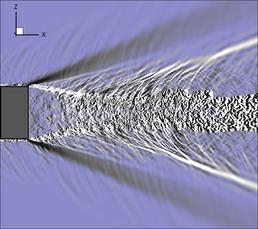Supersonic axisymmetric wakes
- Started
- 1st September 2007
- Ended
- 31st August 2012
- Investigators
- Richard Sandberg
Ideally, supersonic objects would be fitted with streamlined afterbodies to avoid large drag forces. However, in many applications, such as coasting rockets or missiles, the object presents a blunt base to the flow. A recirculation region forms behind the base of the body that is responsible for a low base pressure, thus causing aerodynamic drag (base drag). Flight tests with projectiles have shown that the base drag may account for up to 35% of the total drag. The current project is focused on investigating the origin and dynamics of large-scale structures in the near wake and to devise efficient flow control measures for base drag reduction. The primary research tool is direct numerical simulation.
Categories
Physical Systems and Engineering simulation: CFD
Algorithms and computational methods: FFT, Finite differences
Simulation software: HiPSTAR
Visualisation and data handling software: TecPlot
Software Engineering Tools: CVS, SVN
Programming languages and libraries: Fortran, MPI, OpenMP
Computational platforms: HECToR, Iridis
Transdisciplinary tags: HPC, Scientific Computing
